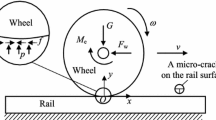Abstract
The Rolling contact fatigue (RCF) damage of high-speed wheels is a main factor that affects railway safety. This paper presents a Finite element model (FEM) of high-speed transient rolling contact that considers kinetic parameters as initial conditions. This model is used to calculate wheel/rail RCF. With a CRH2 high-speed train as the research object, a head car model is established with the multibody dynamics software UM. The train is driven on a straight track at a speed of 300 km/h. Different contact geometric parameters, such as lateral displacement and attack angle, are obtained. A 3D high-speed transient elastic-plastic FEM of wheel/rail rolling contact is then developed by using ABAQUS with the initial dynamic contact geometric parameters. The actual geometries of the wheel tread and rail head as well as the elastic-plastic properties are considered in this model. This consideration makes the model highly suitable for solving 3D transient rolling contact behavior. The normal force, creep force, and contact area in the contact patch are solved and used in the fatigue model. Owing to the hunting movement of wheels, the wheel/rail force and lateral displacement change significantly at 0.2 and 0.5 s. The longitudinal and lateral creep force increase sharply with the increase in shear stress. The work states of the wheel/rail at 0.2 and 0.5 s easily reach the ratchet effect zone, and the fatigue index is large. The fatigue damage of the wheels is generally near the nominal rolling circle.
Similar content being viewed by others
References
D. Tiesong, L. Wei, W. Zefeng and J. Xuesong, Prediction on rolling contact fatigue crack initiation life of rails, Lubrication Engineering, 38 (8) (2013) 46–51.
C. Shihao et al., Research of the differences between Hertz theory and finite element method to analyze the fatigue of wheel/rail contact, Journal of Mechanical Engineering, 51 (6) (2015) 126.
M. Taraf et al., Numerical analysis for predicting the rolling contact fatigue crack initiation in a railway wheel steel, Engineering Fracture Mechanics, 43 (3) (2010) 585–593.
D. H. Lee, J. W. Seo and S. J. Kwon, Numerical analysis of the effect of slip ratio on the fatigue crack initiation life in rolling contact, Advanced Materials Research, 891–892 (2014) 1791–1796.
D. Junjun, Z. Liangwei and L. Fu, Research on rail rolling contact fatigue based on the damage function, Journal of China Railway Society, 33 (1) (2011) 19–24.
C. Chongyi, A study on wheel/rail rolling contact theory based on finite element method and it’s applying, Scientific Research on Chinese Railways(2010).
X. Zhao and Z. Li, The solution of frictional wheel-rail rolling contact with a 3D transient finite element model: Validation and error analysis, Wear, 271 (1) (2011) 444–452.
M. Pletz, W. Daves and H. Ossberger, A wheel set/crossing model regarding impact, sliding and deformation—Explicit finite element approach, Wear, 294–295 (2012) 446–456.
N. Nakano and Y. Terumichi, Numerical analysis for coupled train considering 3D wheel/rail contact geometry, Journal of Mechanical Science and Technology, 29 (7) (2015) 2677–2683.
X. Zhao, 3D transient finite element model for high-speed wheel/rail rolling contact and its application, Journal of Mechanical Engineering, 49 (18) (2013) 1–7.
Z. Wen, L. Wu, W. Li, X. Jin and M. Zhu, Threedimensional elastic-plastic stress analysis of wheel-rail rolling contact, Wear, 271 (1–2) (2011) 426–436.
K. D. Vo, A. K. Tieu, H. T. Zhu and P. B. Kosasih, A 3D dynamic model to investigate wheel-rail contact under high and low adhesion, International Journal of Mechanical Sciences, 85 (2014) 63–75.
J. F. Brunel, E. Charkaluk, P. Dufrénoy and F. Demilly, Rolling contact fatigue of railways wheels: Influence of steel grade and sliding conditions, Procedia Engineering, 2 (1) (2010) 2161–2169.
B. Dirks and R. Enblom, Prediction model for wheel profile wear and rolling contact fatigue, Wear, 271 (1–2) (2011) 210–217.
S. Hossein Nia, C. Casanueva and S. Stichel, Prediction of RCF and wear evolution of iron-ore locomotive wheels, Wear, 338–339 (2015) 62–72.
A. Bevan, P. Molyneux-Berry, B. Eickhoff and M. Burstow, Development and validation of a wheel wear and rolling contact fatigue damage model, Wear, 307 (1–2) (2013) 100–111.
J. Tunna, J. Sinclair and J. Perez, The development of wheel wear and rolling contact fatigue model -RSSB Report for Task T549, Rail Safety and Standards Board(2007).
People’s Republic of China Ministry of railways, Trains 2008 No.28 High speed EMU Test Specification, Beijing: General Office of the Ministry of railways(2008).
Y. Jizhong, Aerodynamic effect on running safety and stability of high-speed train, Southwest Jiaotong University(2010).
L. Guofang, Y. Yongming and D. Wangcai, Modeling and simulation analysis of vehicle-track coupling dynamics, Journal of Lanzhou Jiaotong University, 35 (1) (2016) 142–146.
X. Qian, X. Hongxia and Z. Hai, Creep characteristics of high-speed wheel-rail steady-state rolling contact under different attack angles, China Railway Science, 35 (1) (2014) 606–666.
Author information
Authors and Affiliations
Corresponding author
Additional information
Recommended by Associate Editor Jin Weon Kim
Q. Xiao received his bachelor and master degrees in mechanical engineering from East China Jiaotong University in 2001 and 2005, respectively. He received his Ph.D. degree in vehicle operation engineering from China Academy of Railway Sciences in 2012. His research interests include wheel-rail interaction of high-speed trains, computer-aided design, and computer-aided engineering.
Rights and permissions
About this article
Cite this article
Xiao, Q., Zheng, J., Liu, J. et al. Analysis of the wheel/rail rolling contact fatigue of a high-speed train under the transient mechanism. J Mech Sci Technol 31, 2235–2242 (2017). https://doi.org/10.1007/s12206-017-0420-x
Received:
Revised:
Accepted:
Published:
Issue Date:
DOI: https://doi.org/10.1007/s12206-017-0420-x




